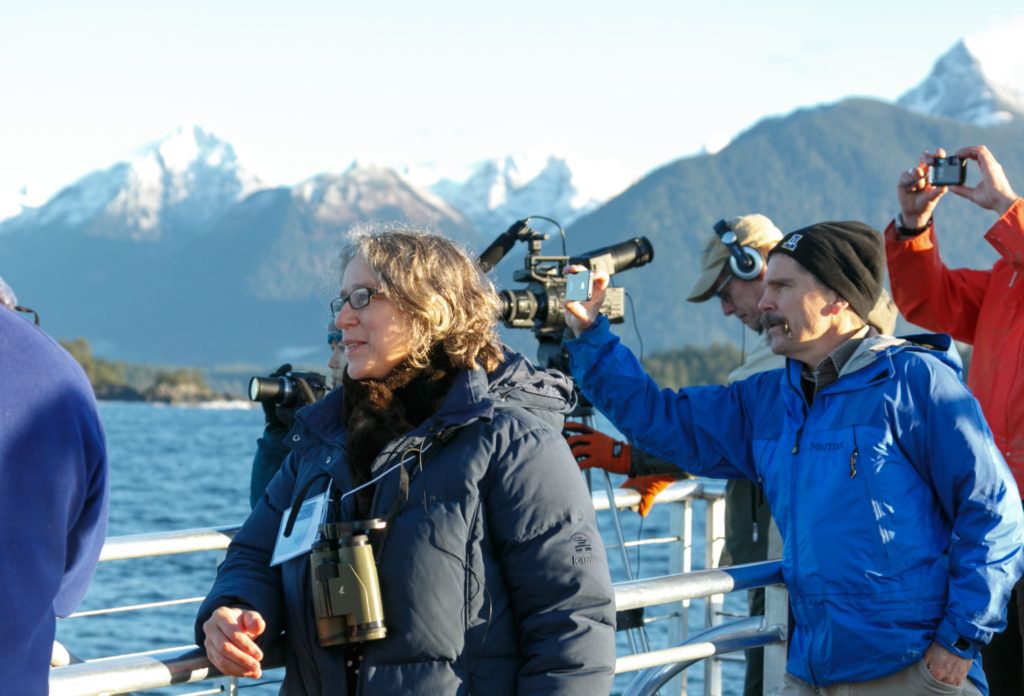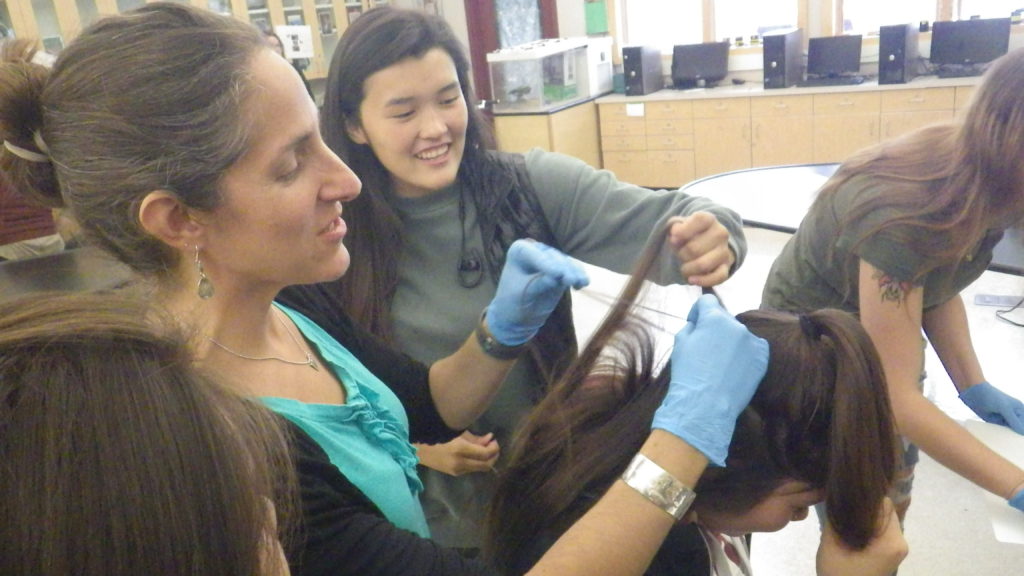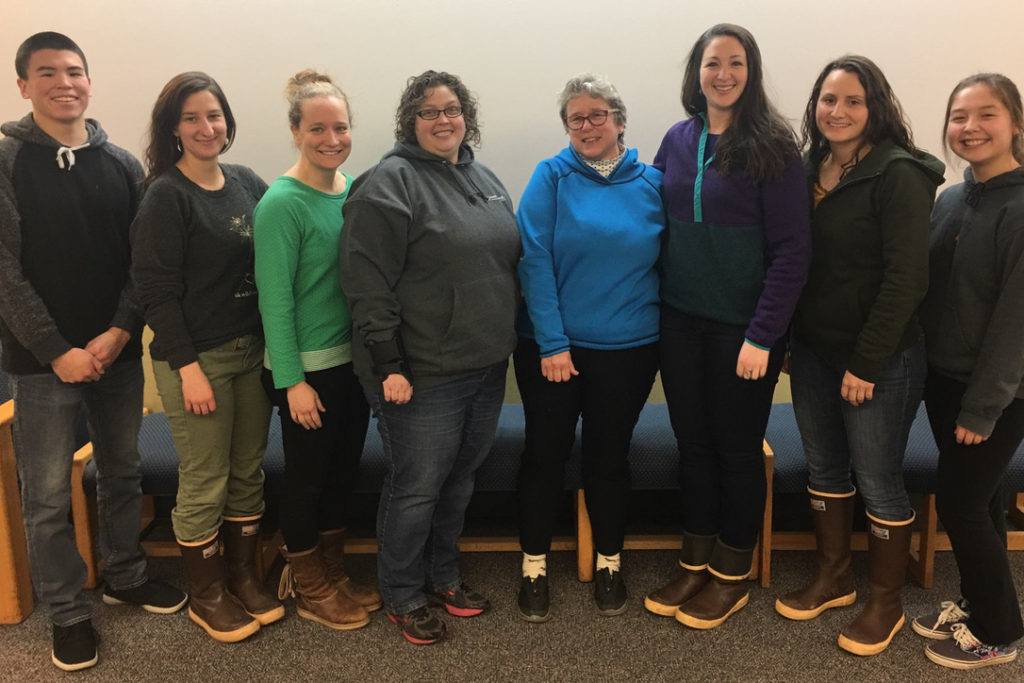Passing the Baton: Sharing Marine Mammal Science Across Generations
By Suzanne Portello
These days, in marine science education in Southeast Alaska, turns out that “sharing” is the name of the game.
Much of the philosophy (and some of the structure) of scientific sharing that now exists in this place is largely the offspring of Sitkan Jan Straley. Having lived in Alaska since 1979, Straley is famous for her decades-long research, writing and photography about whales. Equally important, though perhaps less well-known, is Jan’s influence on at least two generations of Alaskan scientists.

Sitka WhaleFest Science Director Jan Straley talks to guests on wildlife cruise, 2013. (Photo courtesy of Sitka WhaleFest.)
On one day in early 2019, I spoke with Jan Straley and two Sitka-born-and-raised scientists who work closely with her – Lauren Wild and Chohla Moll. Straley, who is a professor at UAS (University of Alaska Southeast) in the Department of Natural Sciences, and on the faculty at UAF (University of Alaska Fairbanks), also operates an independent, partially grant-funded marine research lab here in Sitka. Characteristically, the three women partnered in a sort of round-table discussion to create a composite picture of the work they do.
Lauren Wild spoke first: “I started interning with Jan in the mid-2000s which led to a research assistant position with her. Through working with her I got my masters and I am now a PhD student in her lab. So, I went from intern to technician, to running portions of her lab, to student, back to technician and now back to student. And Jan has been my main mentor in all those phases, currently as a member of my graduate committee.”
Suzanne: “Then, Chohla is a science teacher at Mt. Edgecumbe High School.”
Chohla: “So, my relationship with Jan started when I was in high school, in 1997 – she was my mentor for my senior project. The work that I did with Jan kind of kept me going through college; I would look back on it when I was in organic chemistry and physics…and I would tell myself, well, I have to do this really hard chemistry and physics stuff before they’ll allow me to do the biology I really love.”
“Because of the work I had done with Jan I was able to get a job at Glacier Bay National Park during my (college) undergrad time, and I got additional research experience there. I moved back to Sitka in 2005 to teach at Mt. Edgecumbe High School and have been working with Jan ever since, to try and create experiences for my students, authentic experiences like I had gotten as a high school student.”
Lauren: “A couple of other (graduate) students in our lab have similar ‘Jan’ stories. One is Ellen Chenoweth – she was originally from Michigan and wanted to study whales, so she moved to Glacier Bay and got in with the whale research group (who knew) Jan from her humpback whale monitoring. Ellen got in touch with Jan and ended up in Sitka working as her lab tech starting in 2008 or 9. After several years, Ellen worked with Jan to get into a PhD program at UAF. Jan was on her graduate committee and Ellen got her PhD in August of 2018. Now she’s working with the university and working in Jan’s lab.”
Chohla: “Ellen is actually mentoring some of my high school students. She’s kind-of running the Southeast (Alaska portion of the) BLaST Program, (which) connects mentors with students, who are receiving college credit. Lauren is also mentoring my students.”
Lauren: “The other (grad) student in our lab is Madison Kosma. She’s a master’s student and Jan’s on her graduate committee. Madison moved to Sitka as an AmeriCorps volunteer in 2012 to be at the Science Center and help run WhaleFest. Then, she became the director of WhaleFest, worked closely with Jan and got research opportunities. (Madison) works with Humpback Whales in our lab. Both she and I are funded for our graduate work through BLaST, which stands for “Biomedical Learning and Student Training”.1 It’s an NIH grant to UAF that’s all about getting rural, underserved and minority students trained and experienced in biomedical learning and “One Health Paradigms” – connecting animals and humans in the environment – which is a lot of what we do in Jan’s whale lab.”
“As part of the BLaST program, we’re encouraged to mentor undergrad students.2 Sitka has kind of non-traditional undergraduate students. Back in 2017 Ellen and I started this unit with Chohla’s field research class, to teach them about stable isotopes – which are one way to look at diet in animals and humans. So, we built this little program with Chohla where we go into her class and we teach this unit on stable isotopes. Students compare their diets in their home communities to their diet at school in Sitka through stable isotopes in their hair.”

Chohla Moll, taking a sample of MEHS student hair to test for stable isotopes. (Photo courtesy of Lauren Wild.)
Chohla: “One thing Lauren and Ellen do a very good job of, is working with my students on a really difficult subject like stable isotopes – definitely a high-level subject you wouldn’t normally talk about with high schoolers. So, they teach my students this unit and have them as interns in their labs, but they also let the students ask some of their own questions. One student from Nome was a big subsistence hunter, and he was interested in figuring out some of the stable isotopes that were in his food, so he had some food sent down – some (whale) bowhead and walrus samples from his freezer at home and he checked them out while working on an individual internship with Lauren in the lab.”
“And he found some interesting things – preliminary, but it got him excited about expanding that project, and he was actually able to go up to Nome and Lauren went with him and (they) presented at the Western Alaska Interdisciplinary Science Conference. He was the only high school student to speak at the conference and it was in his home town of Nome, and Lauren supported him in that. It was a huge deal for a high school student to be able to contribute to the scientific community in that way…”
Lauren: “His name is Orlin Gologorgen. My other (high school) student last year, Annie Masterman, is now a freshman at UAS in Juneau, and she looked at squid species offshore using stable isotopes and where they fall in the food chain. She presented a poster of her project in January, up in Anchorage at the Alaska Marine Science Symposium…and she did an awesome job!
Jan: “You would have been proud of her, Chohla.”
Lauren: “When she moved to Juneau, we got her connected to some colleagues at NOAA3 doing research in Prince William sound and she is continuing to do research. So, these are all students that are doing great things, originating from Jan’s lab.”
Jan: “But way more formalized, with Chohla there”
Suzanne: “When I was reviewing the online literature about you three, I came across a few specific projects. One of them was called, ‘Humpback Whale Predation on Juvenile Salmon at Hatchery Release Sites.’”
Jan: “That project is what Ellen Chenoweth has been working on, and now Madison Kosma is working with that interaction.”
Suzanne: “Also mentioned online was the SouthEast Alaska Sperm Whale Avoidance Project.”
Lauren: “So, that’s the project I work with, that Jan, Tory O’Connell, and Linda Behnken co-founded (co-PIs) back in 2003. It is known as SEASWAP,4 which is basically a collaboration between fishermen, scientists and managers to better understand sperm whales interacting with commercial longline fishing gear… specifically black cod – and (then) we work on minimizing those interactions. I started with them as a research tech in 2009. It’s a kind of a collaborative group, so there’s a lot of partner organizations involved – UAS (Jan), Sitka Sound Science Center5 (Tory O’Connell), Alaska Longline Fishermen’s Association6 (Linda Behnken & Dan Falvey), Scripps Institution of Oceanography7 (Dr. Aaron Thode, acoustics), UAF8 (Lauren & Dr. Russ Andrews, whale tagging), and more…”
Jan: “It goes on and on – we also partner with Fish and Game and NMFS9 (National Marine Fisheries Service).”
Suzanne: “According to UAF, Lauren, one of your special interests is acoustics – sperm and humpback whale acoustics?
Lauren: “Yes, when I first started with the sperm whale project in 2009 with SEASWAP, I was hired as a research tech, and I (got training) in sperm whale acoustics with Dr. Aaron Thode from Scripps – kind of the acoustics lead, so I started going out and helping with his work and (finally) started managing the acoustics field work out of Jan’s lab.
Chohla: “I do have one student who’s an intern here at the whale lab, doing his internship on acoustics. He’s also a student of Michael Mahoney – another science teacher at Mt. Edgecumbe who does a whole class on bio-acoustics. This student’s doing acoustic work through the HARP program (high-frequency acoustic recording package) and this is his second semester with that. His name is Brayden Bahnke and he’s from Nome.”
Lauren: “Brayden is working with Jan at the lab and is doing a humpback whale acoustics project…so he’s looking at snippets of Humpback song and how they’re used on the foraging grounds here in Alaska and comparing that to down in Hawaii.”
Lauren: “Chohla’s students do other internships besides with us, so she’s got students that also intern with the Tribe (Sitka Tribe of Alaska) and the Sitka Sound Science Center.”
Jan: “Chohla, who’s the student that wanted to go up to the subsistence board?”
Chohla: “Jaylen Martinez. She’s one of the interns for the Science Center, and actually the work that she did with Jan – the class with the federal subsistence board – she’s interested in herring, and so her internship with the SSSC is with Lauren Bell, trying out how to figure out how to grow herring…”
Jan: “It goes beyond the three of us, is what I’m saying. It’s like an octopus with a lot of tentacles. These interactions between whales and fisheries and humans are what inspired the name for our lab, and we’ve started a University of Alaska whale foundation fund.”

Members of CHIL lab, 2018 (from left to right): Orlin Gologergen, from Nome, AK, who was an MEHS senior at the time, mentee of Lauren Wild; Kristina Long, a UAS Fisheries technology undergraduate student in Sitka, mentee of Lauren Wild; Ellen Chenoweth, a Ph.D. candidate at the time, now a Ph.D. in fisheries from UAF College of Fisheries & Ocean Sciences;Jennifer Cedarleaf, lab manager of UAS Whale Lab (Jan’s assistant); Jan Straley herself; Lauren Wild, UAF College of Fisheries & Ocean Sciences Ph.D. Candidate; Madison Kosma, UAF College of Fisheries & Ocean Sciences Master’s student; Annie Masterman, from Bethel, AK, an MEHS Senior at the time, now a UAS Juneau campus college freshman, mentee of Lauren Wild. (Photo courtesy of Lauren Wild.)
Lauren: “It’s the Cetacean-Human Interaction Lab – CHIL. And then, Jan has a research foundation set up with the University of Alaska that folks can donate to.10 When we don’t have a dedicated project or grant for something, it’s hard to find funds to pay for the boat, for fuel to go out and do research, process samples in the lab, impromptu stuff – that foundation helps for projects that arise that we don’t have grant funding for.”
Suzanne: “So, Chohla, tell me, how did growing up as the child of two science teachers influence you in your aspirations? What is your favorite thing about teaching science?
Chohla: “Well, growing up I thought that I was not going to be a teacher but ‘a real scientist’ (Ha!) Storytelling and relationships – relationships are the best! Helping students make real world connections (involving science research) – schedules, permissions, rules.
Suzanne: “I love the NPR.org piece on you where you talk so relaxedly about your (Alaska Native) heritage – any comments on how that informs your teaching?”
Chohla: “I try to create experiences for students.”
Lauren: “The cool thing is…none of this would be able to happen if we weren’t all wanting the same thing for the students and able to work together. None of this would happen if we didn’t have the connection with Chohla and Edgecumbe…she’s so easy about just letting us come into her classes… we have all these crazy things we want to do with students to get them more excited and into science and successful at science.”
Suzanne: “And Chohla keeps you anchored as to what’s really going to work in the classroom setting?”
Lauren: “Yes, exactly, and she helps facilitate it, because there’s a lot of behind-the-scenes paperwork and logistical work that has to happen to get these kids these opportunities… and Jan and Chohla, between the university system and the high school system, make that happen.”
—
For those interested in finding out more about some of the programs and organizations mentioned in this article:
- BLaST, Biomedical Learning and Student Training Home Page alaska.edu/blast
- BLaST page on Graduate Mentoring Research Assistantships (GMRA) alaska.edu/blast/blast-gmra
- NOAA Lab at Auke Bay, Juneau fisheries.noaa.gov/about/auke-bay-laboratories
- SEASWAP seaswap.info/team/
- Sitka Sound Science Center sitkascience.org
- Alaska Longline Fishermen’s Association alfafish.org/what-we-do
- Aaron Thode at Scripps Institute of Oceanography scrippsscholars.ucsd.edu/athode
- Russ Andrews at UAF uaf.edu/cfos/people/faculty/detail/index.xml?id=63
- NMFS (National Marine Fisheries Service) alaskafisheries.noaa.gov
- Donations can be made to Jan’s Whale Research Foundation either online or over the phone: Donors contribute securely online to the Whale Research and Education fund at engage.alaska.edu/UAS by selecting “Other” in the “Designation” drop-down menu and typing “Whale Research and Education” or “Sitka Whale Research,” etc. Donors can also contribute over the phone by credit card by calling the Donor Relations office at 907-796-6320.
